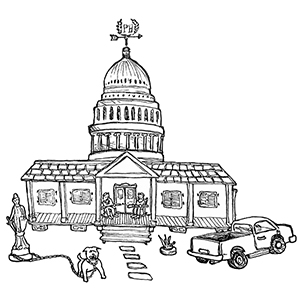The Rise of Trumpism
In today’s politics, Donald Trump supporters praise him as welcome relief to what they consider failed politics and policies. Trump opponents see him as narrow minded and intemperate. But there’s more. In a December 2023 national poll, 51 percent of the respondents agreed that Trump would be “a threat to democracy if he is elected president.” Yet in the same poll asking about the November 2024 presidential election, the respondents favored Trump over Democratic incumbent Joe Biden 47 percent to 42 percent. So, what is it that makes Trump so appealing, given that so many believe he will hurt democracy as president? We learn something of an answer in diagnosing Trumpism, the movement that has catapulted Donald Trump to the presidency.

Artist: Pedro Camargo
Trumpism offers a simplistic political design for attending to society’s problems, washing away political demons (and enemies) in the process. In essence, followers view it as a political cleansing agent with the promise of permanent change. Trumpism is now a part of American politics and culture, extending well beyond its namesake.
An Anti-Democratic Combination
Trumpism is manifested through the interaction of four central properties: populism, racism, isolationism, and authoritarianism. Combined, these elements have become a powerful socio-political mechanism for undermining democracy and pushing American society into chaos.
Populism
At its root, populists recoil from abrupt change. In post-Civil War America, the country moved swiftly toward industrialization and urbanization, creating a sense of abandonment for some sectors of society. And so emerged populism. Many small town residents and members of the agricultural sector particularly felt ignored and left behind. Racism, antisemitism, and a general fear of immigrants were mainstays in populism. The growing dominance of government as well as large corporations were also blamed for an unnatural reordering of society. Waxing nostalgia, people yearned for someone to lead them to a simpler and calmer past. Briefly a small political party, the populist movement waned by the late 1890s.
In recent years, populism has re-emerged in American society. Growing resentment of “bigness” whether by Big Government, large corporations, outsized interest groups, and massive immigration have led large numbers of Americans to look for someone able to regain control of the American dream.
Few modern politicians have seized populism as a tool for power more successfully than Donald Trump. Repeatedly, he has pinpointed grievances against immigrants and minorities, who are “stealing our culture,” exhorting his supporters to “take our country back.” And how can such devastating developments be overcome? Trump would ask rhetorically. “I am your voice,” Trump declared during the 2016 Republican National Convention. And with respect to the myriad problems emerging from the deterioration of American greatness, Trump pronounced, “I alone can fix it.” The delegates roared with approval
Racism
When Trump urges his rally attendees to join him in the fight to “take our country back,” one might ask, from who? The answer is, from those robbing us of “our culture.” It boils down to “us” versus “them.” The “us” represents largely White Christians, guardians of the American dream and preservationists of culture molded by White Christian forbearers. The “them” are found mostly with Black, Brown, Indigenous, and Asian Americans, immigrants of color, and members of non-Christian religions. This approach has served as a powerful force for leaving a major wedge between Americans.
Once he became a contender for the 2016 presidential election, Trump made racism a centerpiece of his candidacy. He accused Mexico and other Latin American countries of sending rapists, crime, and drugs. Upon his election in 2016, Trump pledged to deport every one of the nation’s undocumented immigrants, even though close to half in the U.S. were guilty of nothing other than entering legally and overstaying their visas.

Artist: Drew Martin
An early presidential test of Trump and bigotry occurred in 2017 when a peaceful group in Charlottesville, Virginia gathered to support removal of a Confederate monument and were viciously attacked by a group of torch-carrying men displaying Nazi symbols and chanting “Jews will not replace us.” At the end of a melee where one person died and dozens of non-violent demonstrators were injured, Trump complained that “the press has treated [the Neo-Nazis] unfairly….You had some very fine people on both sides.”
But there was so much more. During his presidency Trump attacked supporters of the non-violent Black Lives Movement for disseminating “toxic propaganda,” tried to ban all Muslims from entering the United States, and labeled undocumented immigrants entering the United States from Latin American countries “animals.” And who can forget Trump’s reference to COVID-19 as the Kung Flu, his attempt to blame China for causing the virus?
“Birtherism,” the baseless belief that a candidate for national office is born outside the United States, has been a favorite tool for Donald Trump. Between 2012 and 2016, he frequently wondered aloud whether then-President Barack Obama, an African-American born in Hawaii, was from Kenya (his father’s place of birth). Later, Trump used the same tactic on then-Democratic Vice-Presidential candidate, Kamala Harris, the child of Jamaican and Indian immigrants who was born in Oakland, California. As with the first claim against Obama, conspiracy theorists spread the false claim like wildfire.
Variations of Trump’s racism continue to this day. During the 2024 campaign, he employed anti-immigrant and antisemitic rhetoric once used by Adolph Hitler, describing them as “vermin…poisoning the blood of our country.” Taking a swipe at Republican challenger Nikki Haley, an Indian American, Trump has referred to her as Nimarata Nikki Haleyand claimed that she was ineligible to run for president. In fact, Nikki Haley was born in South Carolina and, hence a U.S. citizen. Nimarata was her given first name, but she has gone with her middle name for most of her life. Clearly, racism is a mainstay of Trump’s political arsenal.
Isolationism
Isolationism refers to the practice of a nation behaving inwardly with respect to interaction with other nations. For more than one hundred years, American isolation was guaranteed by oceans to our east and west. U.S. isolation ended briefly with late participation in World War I, after which Americans resumed an inward attitude. Even when Hitler menaced Europe and Japan attacked China and other nearby nations, America resisted involvement. That distance ended in theory with the attack on Pearl Harbor by Japan on December 7, 1941.
Economically, militarily, and politically the international role of the United States changed markedly after World War II. From that point on, the United States became the most powerful nation in the world, working with allies to create the North American Treaty Organization (NATO), where an attack on any member would be an attack on all with a commensurate response. Over time, the collection of NATO nations has grown to 32 members.
Currently, the U.S. has seven collective military arrangements with various groups of nations all over the world, with the most recent being coordination with NATO partners for aid to Ukraine against a Russian invasion in 2022. These changes have led some Americans to wonder about the extent of American investments—military and political—abroad.
But isolationism goes beyond severing relationships with other countries. For Donald Trump, saving America and protecting social homogeneity are part of his effort to not only separate the United States from other countries, but to keep the U.S. from accepting the “thems” from other countries. He has embraced isolationism as the basis for its “America First” policy, part of his “Make America Great Again” slogan. If the phrase sounds familiar, it’s because it was the call of those American Nazi sympathizers during the 1930s who wanted the United States to stay away from the fighting in Europe.
When discussing American assistance to allies during his presidential campaign in 2024, Trump has argued against it. The military agreements between the U.S. and allies, he argues, have been prohibitively costly to the U.S. and not worth the investment. This shouldn’t be a surprise. As President, Trump scuttled a several-nation nuclear agreement with Iran, withdrew the United States from the Paris Climate Accord, and renounced American participation in the Trans-Pacific Partnership designed to contain China’s influence in Asia. Toward the end of office, Trump pondered leaving NATO and told European leaders if he returned to the presidency, the United States would never help Europe if a member country suffered attack.
Authoritarianism
Authoritarianism is an approach to rule resting on intolerance of differences and imposed group conformity. There is only one accepted form of behavior, the one declared by the leader and supported by his sycophants; deviation from an enforced value system is not permitted. If necessary, authoritarians will rely on physical strength to compel acceptance of their rule.
Donald Trump believes in authoritarianism. He has declared that only he knows what’s best for the United States. Recall Trump’s assessments of America’s problems at the 2016 Republican convention, where he promised the delegates that “I am your voice,” and that regarding the nation’s condition, “I alone can fix it.” From Trump’s perspective, it was more important for the nation to follow him than interact with him.
Trump feels particularly comfortable with fellow autocrats. In fact, he has expressed undying admiration for despots. Often, he has voiced effusive praise on China’s Xi Jinping, Russia’s Vladimir Putin, North Korea’s Kim Jong-Un, Hungary’s Viktor Orban, Turkey’s Recep Erdogan, and Egypt’s Abdel Fattah el-Sisi. In Trump’s words, “the tougher and meaner they [autocrats] are, the better I get along with them….” On assessing the leadership of Xi Jinping, Trump said of the Chinese leader, “President for life! That’s pretty good.”
His four years as President offered ample evidence that Trump was fully committed to authoritarianism. Some examples:
- Firing F.B.I. Director James Comey for his unwillingness to give Trump total loyalty; Comey’s loyalty was to the Constitution.
- Obstructing the Special Counsel appointed by Trump’s Deputy Attorney General to examine possible Russian interference relating to the 2016 presidential election.
- Issuing executive orders making it easier for executive department and agency heads to fire civil servants.
- Deriding the press for presenting “fake news,” which was information Trump didn’t like.
- Upon losing the 2020 election, he asserted that the best way to undo his defeat would come from terminating the Constitution.
- Ordering federal officials to seize the voting machines in several states that went for Biden in the 2020 election.
- Supporting the January 6, 2021 insurrection against the Capitol as Congress met to confirm the election results.
All told, Donald Trump used his presidency to maximize his power and prevent anyone from interfering with his activities.
Losing his re-election in 2020 only emboldened Trump for his next calling in 2024. Shortly after he declared for the presidential nomination in 2023, Trump recited his grievances about the “rigged results,” and told his followers at his first rally, “I am your retribution.” Translation: Once in office, Trump would get even with his tormentors. He later spoke of executing at least one opponent from his administration who interfered with Trump’s efforts.
Trumpism: More than an Idea
Combined, populism, racism, isolationism, and authoritarianism became the essential ingredients of Trumpism. As interacting components, they make Trumpism the most powerful anti-democratic threat in the nation’s history.
The Restructuring of American Values
Trumpism is a powerful political force, especially for those living in fear—fear of surrendering their place in society to others, fear of government-imposed constraints on their lives, fear of losing their way of life. These examples show how Trumpism thrives on the “us” versus “them” classification of society and the results that follow. That very chaos is the source of strength for Donald Trump and his allies.
It’s important to note that in America, divisions are not new. There have always been tensions between Whites and non-Whites, Christians and non-Christians, anchored citizens and newcomers. The very multicultural nature of American society virtually guarantees such tensions; they are endemic to a pluralistic society. But for the most part, throughout the nation’s history, there have been constraints on what those in power could do to the powerless, whether from competing government entities or the voters.
Increasingly, the voices of those seeking fairness have been overcome by Trumpists who have no such interest or care. Its power has impacted our lives to the extent of promoting hate over tolerance, order at any price, and institutionalized discrimination over informal prejudice. As a result, today we live in an environment that threatens to alter American cultural values.
Hate Over Tolerance
In a democracy, we don’t have to agree with others; rather, we need to acknowledge that others may not see things as we do and respect their points of view. From there, good governance comes from those with differing opinions who, on the same issue, seek common ground. This is the essence of tolerance.
Hate, however, interferes with democracy to the extent that it is a key component of authoritarianism. It doesn’t have to be that way. Studies show that tolerance in America on issues related to race grew substantially between the 1960’s and 1990’s. But that seems to be a bygone era. With Trumpism, tolerance has given way to hate and intolerance, especially with respect for racial, ethnic, and religious minorities. Research shows that during the 2016 presidential campaign, hate crimes increased in counties that voted for Trump. Another data point: Nationwide research by ABC on the relationship between Trump and violence found at least 54 instances between 2015 and 2020 where Trump supporters physically attacked anti-Trump supporters, sometimes during or after rallies and other times where they cited Trump’s name as the source of their anger. Most of the attackers were White young men, similar to the profile at the infamous January 6, 2021 insurrection against the Capitol.
Trump’s open contempt for minorities and immigrants has opened the door for hate groups to act out their anger. Their menacing presence at Trump rallies, willingness to take on peaceful protesters, and threats against election officials simply trying to do their jobs speak volumes about their willingness to dismember American society as we know this. And Trump has expressed his approbation in rather direct terms. We only have to recall a 2020 presidential debate between Trump and Biden. When asked by the moderator to condemn violence the Proud Boys, a well known hate group, Trump responded, “Proud Boys, stand back and stand by.” Within minutes, that statement circulated through the dark places of social media. The surge of Trumpism-inspired hate in the United States has lessened the commitment to democracy. Most of the assaults were against minorities including African-Americans, Latinos, Muslims, and gay men.
Order at Any Price
In early 2024, Donald Trump pronounced that upon resuming the presidency, he would be a “dictator,” ruling with an iron fist. After his candid remark provoked widespread concern, Trump amended his statement, saying that he would be a dictator for his first day only. Nevertheless, Trump made the point. Giving a speech on Veterans Day in 2023, when leaders traditionally honor military personnel who have defended the United States in times of war, Trump vowed to “root out the communists, Marxists, fascists, and the radical left thugs that live like vermin within the confines of our country that lie and steal and cheat on elections” upon his return to office.
Trump has plenty of authoritarian followers, which makes his behavior all the more frightening for those concerned with losing our democracy. All we have to do is remember the 147 members of Congress (139 in the House of Representatives and 8 in the U.S. Senate) who on January 6, 2021, after the insurrection against the Capitol, voted to overturn the results of the 2020 election despite the absence of any evidence. In fact, some members rejected the thought of an insurrection altogether, suggesting that the insurrection was little more than a tour of the Capitol. Republican Representative Paul Gosar (AZ) went so far as to categorize the insurrectionists as “peaceful patriots.”
The growing comfort with order at any price has seeped into large swaths of American society. A 2023 national poll asked whether “we need a leader who is willing to break some rules if that’s what it takes to set things right.” Thirty-eight percent of the respondents agreed with the idea, including 48 percent of Republicans. That survey is not an outlier. In a 2022 national survey of Americans, 42 percent agreed that “having a strong leader is more important than having a democracy.” Simply put, Trumpism has impacted American society.
Lost Faith in Democracy
The restructuring of American culture to include hate and violence coincide with the beliefs of many that American democracy is on the wane. In a 2022 national survey of Americans, 52 percent were “very concerned” with the future of American Democracy. Another national poll taken by NPR/Ipsos the same year offers an even more dour assessment with 64 percent agreeing that “American democracy is in crisis and at risk of failing.”
What do we do about this? In a democracy, we count on leaders to promote democratic values from the top down to the people. We expect them to set examples, give us hope, and work toward better times. If that’s the case, Trumpists have failed us as leaders, for their grievances focus on division and anger. Trumpists would rather exploit differences than heal them. Instead, they should be focusing on political ways to expand the economic pie and the extoll the benefits of diversity in democracy. So, the broken society goes on, and no one deserves more blame for that than Donald Trump.

